Alfa Romeo MiTo 2017, Mito 1 2017 Owner's Manual

OWNER HANDBOOK

This Owner Handbook illustrates the operating instructions of the car.
Alfa Romeo provides a dedicated section available in electronic format for
enthusiasts who want insights, curiosities and detailed information about the features and functions of the car.
ONLINE OWNER HANDBOOK
The 
 symbol appears in the Owner Handbook next to topics for which updates are available.
symbol appears in the Owner Handbook next to topics for which updates are available.
Go to elum.alfaromeo.com where you will find all the details of the Owner Handbook.
Alternatively, to access this information, go to the Internet website at http://aftersales.fiat.com/elum/.
The eLUM website is free and conveniently allows you to browse the on-board documents of all other models of the Group, among many other things.
Have a nice read and happy motoring!

Dear Customer,
We would like to congratulate and thank you for choosing an Alfa Romeo.
We have written this handbook to help you get to know all the features of your vehicle and use it in the best possible way.
Here you will find information, advice and important warnings regarding use of your vehicle and how to achieve the best performance from the technical features of your Alfa Mito.
You are advised to read it right through before taking to the road for the first time, to become familiar with the controls and above all with those concerning brakes, steering and gearbox; at the same time, you can understand the vehicle behaviour on different road surfaces.
This document also provides a description of special features and tips, as well as essential information for the safe driving, care and maintenance of your Alfa Mito over time.
In the attachedWarranty Booklet you will also find the description of the Services that Alfa Romeo offers to its customers, the Warranty Certificate and the detail of the terms and conditions for maintaining its validity.
We are sure that these will help you to get in touch with and appreciate your new car and the service provided by the people at Alfa Romeo.
Enjoy reading. Happy motoring!

READ THIS CAREFULLY
REFUELLING
Petrol engines: only refuel with unleaded petrol with octane rating (RON) not less than 95 in compliance with the European specification EN228. Diesel engines: refuel only with Diesel fuel motor vehicles conforming to the European specification EN590.The use of other products or mixtures may damage the engine beyond repair and consequently invalidate the warranty, due to the damage caused.
STARTING THE ENGINE
Petrol engines. Versions with manual gearbox engage the handbrake, set the gear lever to neutral; fully depress the clutch pedal without pressing the accelerator, then turn the ignition key to AVVand release it as soon as the engine has started. Versions withTCTgearbox (if available), engage the handbrake and set the gear lever in P (Parking) or N (Neutral), then turn the ignition key to AVVand release it as soon as the engine is started. Diesel engines: turn the ignition key to MAR and wait for the warning light to switch off.Then turn the ignition key to AVVand release it as soon as the engine has started.
warning light to switch off.Then turn the ignition key to AVVand release it as soon as the engine has started.
PARKING ON FLAMMABLE MATERIAL
The catalytic converter develops high temperatures during operation. Do not park the car on grass, dry leaves, pine needles or other flammable material: fire hazard.
RESPECTING THE ENVIRONMENT
The vehicle is fitted with a system that carries out a continuous diagnosis of the emission-related components in order to help protect the environment.
ELECTRICAL ACCESSORIES
If, after buying the car, you decide to add electrical accessories (with the risk of gradually draining the battery), contact an Alfa Romeo Dealership.
They will calculate the overall electrical requirement and check that the car’s electrical system can support the required load.
SCHEDULED SERVICING
Correct maintenance of the car is essential for ensuring that it maintains its performance and its safety features, its environmental friendliness and low running costs for a long time to come.
THE OWNER HANDBOOK CONTAINS
…important information, advice and warnings for correct use, driving safety and maintenance of the car over time. Special attention must be paid to the symbols  (personal safety)
(personal safety)  (environmental protection)
(environmental protection)  (car integrity).
(car integrity).

USE OF THE OWNER HANDBOOK
Each time direction instructions (left/right or forwards/backwards) about the vehicle are given, these must be understood as regarding an occupant in the driver's seat. Special cases not complying with this rule will be specified as appropriate in the text.
The figures in the Owner Handbook are provided by way of example only: this might imply that some details of the image do not correspond to the actual arrangement of your vehicle. In addition, the Handbook has been conceived considering vehicles with steering wheel on the left side; it is therefore possible that on vehicles with steering wheel on the right side, the position or construction of some controls is not exactly mirror-like with respect to the figure.
To identify the chapter with the information needed you can consult the index at the end of this Owner Handbook.
Chapters can be rapidly identified with dedicated graphic tabs, at the side of each odd page. A few pages further there is a key for getting to know the chapter order and the relevant symbols in the tabs.There is in any case a textual indication of the current chapter at the side of each even page.
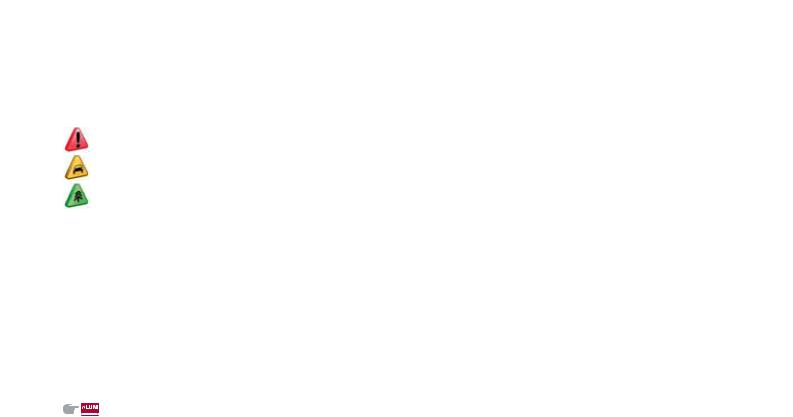
WARNINGS AND PRECAUTIONS
While reading this Owner Handbook you will find a series of WARNINGS to prevent procedures that could damage your vehicle.
There are also PRECAUTIONS that must be carefully followed to prevent incorrect use of the components of the vehicle, which could cause accidents or injuries.
Therefore all WARNINGS and PRECAUTIONS must always be carefully followed.
WARNINGS and PRECAUTIONS are recalled in the text with the following symbols:
personal safety;
vehicle safety;
environmental protection.
NOTEThese symbols, when necessary, are indicated besides the title or at the end of the line and are followed by a number.That number recalls the corresponding warning at the end of the relevant section.
IMPORTANT
This Owner Handbook describes all Alfa Mito versions. Options, equipment dedicated to specific markets or versions are not explicitly indicated in the text: as a consequence, you should only consider the information which is related to the trim level, engine and version that you have purchased. Any content introduced throughout the production of the model, outside the specific request of options at the time of purchase, will be identified with the wording (where provided).
All data contained in this publication are intended to help you use your vehicle in the best possible way. FCA Italy S.p.A. aims at a constant improvement of the vehicles produced. For this reason it reserves the right to make changes to the model described for technical and/or commercial reasons.
For further information, contact an Alfa Romeo Dealership.
VEHICLE CHANGES / ALTERATIONS
IMPORTANT Any change or alteration of the vehicle might seriously affect its safety and road holding, thus causing accidents, in which the occupants could even be fatally injured.

GETTING TO KNOW YOUR CAR KNOWING THE INSTRUMENT PANEL SAFETY STARTING AND DRIVING IN AN EMERGENCY
SERVICING AND MAINTENANCE TECHNICAL SPECIFICATIONS MULTIMEDIA INDEX


GETTING TO KNOW YOUR CAR |
|
INSTRUMENTPANEL. . . . . . . . . . . . . . . . . . . . . . . . . . . . |
.8 |
INSTRUMENTPANEL . . . . . . . . . . . . . . . . . . . . . . . . . . . |
.9 |
THE KEYS . . . . . . . . . . . . . . . . . . . . . . . . . . . . . . . . . . . |
10 |
IGNITION DEVICE . . . . . . . . . . . . . . . . . . . . . . . . . . . . . . |
11 |
ALFA ROMEO CODE SYSTEM. . . . . . . . . . . . . . . . . . . . . . . |
12 |
ALARM SYSTEM. . . . . . . . . . . . . . . . . . . . . . . . . . . . . . . |
13 |
DOORS. . . . . . . . . . . . . . . . . . . . . . . . . . . . . . . . . . . . . |
13 |
SEATS . . . . . . . . . . . . . . . . . . . . . . . . . . . . . . . . . . . . . |
14 |
HEADRESTS . . . . . . . . . . . . . . . . . . . . . . . . . . . . . . . . . |
16 |
STEERINGWHEEL. . . . . . . . . . . . . . . . . . . . . . . . . . . . . . |
17 |
REARVIEWMIRRORS . . . . . . . . . . . . . . . . . . . . . . . . . . . |
18 |
EXTERNAL LIGHTS . . . . . . . . . . . . . . . . . . . . . . . . . . . . . |
19 |
INTERIOR LIGHTS . . . . . . . . . . . . . . . . . . . . . . . . . . . . . . |
21 |
WINDSCREEN / REARWINDOWWIPERS . . . . . . . . . . . . . . . |
22 |
CLIMATE CONTROL . . . . . . . . . . . . . . . . . . . . . . . . . . . . . |
24 |
ELECTRICWINDOWS . . . . . . . . . . . . . . . . . . . . . . . . . . . . |
29 |
ELECTRIC SUNROOF . . . . . . . . . . . . . . . . . . . . . . . . . . . . |
30 |
ENGINE BONNET . . . . . . . . . . . . . . . . . . . . . . . . . . . . . . |
32 |
BOOT. . . . . . . . . . . . . . . . . . . . . . . . . . . . . . . . . . . . . . |
33 |
HEADLIGHTS . . . . . . . . . . . . . . . . . . . . . . . . . . . . . . . . . |
34 |
Alfa DNA SYSTEM (Car dynamic control system) . . . . . . . . . . . |
34 |
DYNAMIC SUSPENSION (active shock absorber system) . . . . . . |
35 |
VERSIONWITH LPG SYSTEM. . . . . . . . . . . . . . . . . . . . . . . |
36 |
In-depth knowledge of your new car starts here.
The booklet that you are reading simply and directly explains how
it is made and how it works.
That’s why we advise you to read it seated comfortably on board,
so that you can see what is described here for yourself.
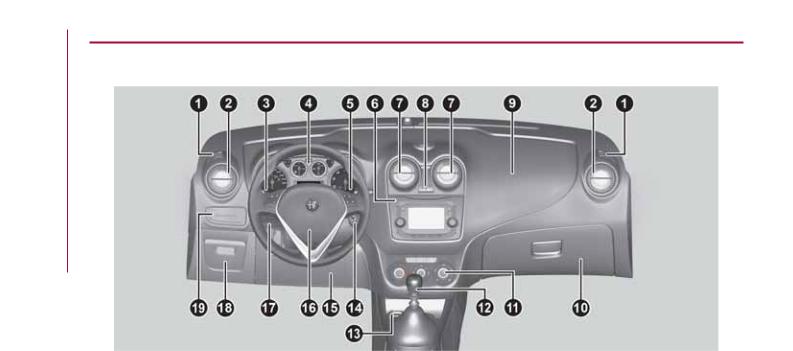
GETTINGTO KNOWYOUR CAR
INSTRUMENT PANEL
Left-hand drive versions
1 |
A0J0330C |
1. Side windows air vents – 2. Adjustable and directable air diffuser – 3. Exterior light control lever – 4. Instrument panel – 5. Windscreen wiper/rear window wiper/trip computer control lever – 6. Uconnect™ (where provided) – 7. Adjustable and directable air diffusers – 8. Hazard warning lights, door locking/unlocking button – 9. Passenger front airbag – 10. Glovebox – 11. HVAC controls – 12. Gear lever – 13. “Alfa DNA” system – 14. Ignition switch – 15. Driver side knee front airbag (where provided) –16. Driver side front airbag – 17. Cruise Control lever (where provided) – 18. Fuse box access flap –19. Panel with various controls.
8
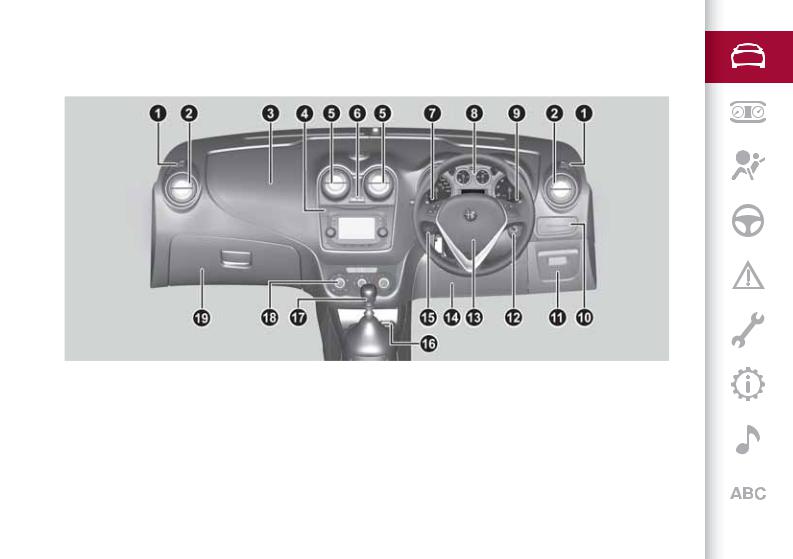
Right-hand drive versions
2 |
A0J0393C |
1. Side windows air vents – 2. Adjustable and directable air diffuser – 3. Passenger front airbag – 4. Uconnect(TM) (where provided) – 5. Adjustable and directable air diffusers – 6. Hazard warning lights, door locking/unlocking button – 7. Exterior light control lever – 8. Instrument panel – 9.Windscreen wiper/rear window wiper/trip computer control lever – 10. Panel with various controls – 11. Fuse box access flap – 12. Ignition switch – 13. Driver side front airbag Front passenger airbag – 14. Driver side knee front airbag (where provided) – 15. Cruise Control lever (where provided) –16. “Alfa DNA” system – 17. Gear lever – 18. HVAC controls –19. Glove compartment
9

GETTINGTO KNOWYOUR CAR
THE KEYS
MECHANICAL KEY
Operation
The metal insert 1 fig. 3 operates:  the ignition switch;
the ignition switch;
 the door lock.
the door lock.
3 |
A0K0545C |
KEY WITH REMOTE CONTROL
(where provided)
 1)
1)
Operation
The metal insert 1 fig. 4 operates the ignition device and the door lock. Press button 2 to open/close the metal insert.
4 |
A0J0072C |
Door and luggage compartment unlock: briefly push button to unlock doors and luggage compartment.This results in interior courtesy lights coming on with a timed delay and a double flash of the direction indicators (only for some versions).
Door and luggage compartment lock: briefly push button to lock doors and luggage compartment.This results in interior courtesy lights coming off and a single flash of the direction indicators (only for some versions).
button to lock doors and luggage compartment.This results in interior courtesy lights coming off and a single flash of the direction indicators (only for some versions).
Opening the luggage compartment: press the button to open the luggage compartment using the remote control.The direction indicators will flash twice to indicate that the luggage compartment has been opened.
button to open the luggage compartment using the remote control.The direction indicators will flash twice to indicate that the luggage compartment has been opened.
REQUESTING ADDITIONAL REMOTE CONTROLS
The system can recognise up to 8 keys with incorporated remote control. Should a new remote control be necessary, contact a Alfa Romeo Dealership and be ready to present the CODE Card (where provided), a personal identity document and the car's ownership documents.
REPLACING THE BATTERY IN THE KEY WITH REMOTE CONTROL
 1)
1)
Procedure
 press button 1 fig. 5 and move the metal insert 2 to opening position; turn screw 4 to
press button 1 fig. 5 and move the metal insert 2 to opening position; turn screw 4 to using a fine bit screwdriver;
using a fine bit screwdriver;
 remove battery compartment 5 and replace battery 3, respecting the polarity; reinsert compartment 5 in the key and secure it by turning screw 4 to
remove battery compartment 5 and replace battery 3, respecting the polarity; reinsert compartment 5 in the key and secure it by turning screw 4 to .
.
5 |
A0J0073C |
10

SAFE LOCK DEVICE
(where provided)
This safety device inhibits the operation of the interior door handles and the door locking/unlocking button.We recommend that you activate this device each time you park your car.
Activating the device
The device is enabled on all the doors by pressing the button on the key twice quickly. Device activation is indicated by 3 flashes of the direction indicators and a flash of the LED on the button
on the key twice quickly. Device activation is indicated by 3 flashes of the direction indicators and a flash of the LED on the button on the dashboard.The device does not come on if one or more doors is not properly shut.
on the dashboard.The device does not come on if one or more doors is not properly shut.
Deactivating the device
The device disengages automatically:  the key insert is turned to opening position in the driver side door;
the key insert is turned to opening position in the driver side door;
 by pressing the button
by pressing the button on the key;
on the key;  by turning the ignition key to the MAR
by turning the ignition key to the MAR
position.
IMPORTANT Once the safe lock system is engaged, it is impossible to open the doors from inside the car.Therefore, before getting out of the car check that there is no one left on board. If the remote control battery is flat, the device can only be deactivated by using the metal insert in one of the door locks.
WARNING
1) Press button 2 only with the key away from your body, especially your eyes and from objects which could get damaged (e.g. your clothes). Do not leave the key unattended to avoid the button being accidentally pressed while it is being handled, e.g. by a child.
IMPORTANT
1) Used batteries may be harmful to the environment if not disposed of correctly. They must be disposed of as specified by law in the special containers or taken to an Alfa Romeo Dealership, which will take care of their disposal.
IGNITION DEVICE
 2) 3)
2) 3)
The key can be turned to three different positions fig. 6:
 STOP: engine off, key can be removed, steering column locked. Some electrical devices (e.g. central door locking system, alarm, etc.) are enabled;
STOP: engine off, key can be removed, steering column locked. Some electrical devices (e.g. central door locking system, alarm, etc.) are enabled;
 MAR: driving position. All electrical devices are enabled;
MAR: driving position. All electrical devices are enabled;
 AVV: engine starting.
AVV: engine starting.
6 |
A0J0031C |
The ignition device is fitted with a safety system that requires the ignition key to be turned back to STOP if the engine does not start, before the starting operation can be repeated.
STEERING LOCK
 4) 5)
4) 5)
Activation
When the key is at STOP, remove the key
11
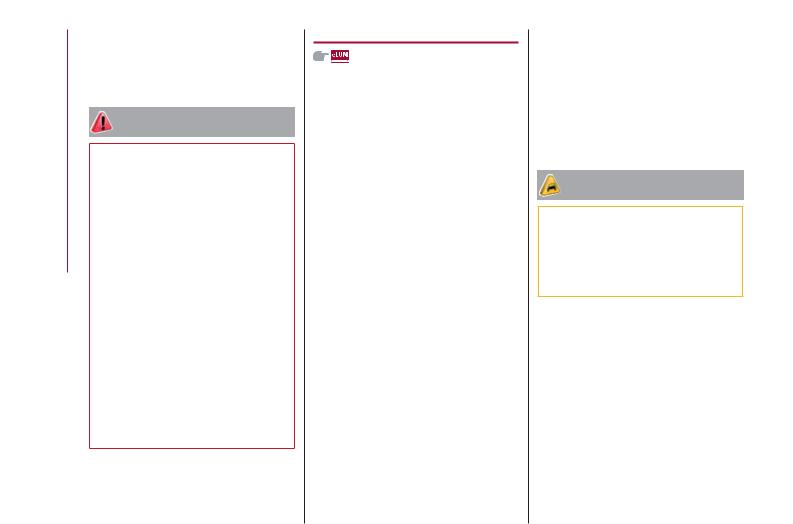
GETTINGTO KNOWYOUR CAR
and turn the steering wheel until it locks.
Deactivation
Move the steering wheel slightly and turn the ignition key to MAR.
WARNING
2)If the ignition device has been tampered with (e.g. an attempted theft), have it checked over by the Alfa Romeo Dealership before driving again.
3)Always remove the key when you leave your car to prevent someone from accidentally operating the controls. Remember to engage the handbrake. Engage first gear if the vehicle is parked uphill or reverse if the vehicle is parked downhill. Never leave children unattended in the vehicle.
4)It is absolutely forbidden to carry out any after-market operation involving steering system or steering column modifications (e.g. installation of anti-theft device) that could adversely affect performance and safety, invalidate the warranty and also result in the car not meeting type-approval requirements.
5)Never remove the key while the car is moving.The steering wheel will automatically lock as soon as it is turned. This holds true for cars being towed as well.
ALFA ROMEO CODE SYSTEM
The Alfa Romeo Code prevents unauthorised use of the vehicle, disabling engine starting.
Operation
Each time the car is started by turning the ignition key to MAR, the Alfa Romeo CODE system control unit sends an acknowledgement code to the Powertrain Control Module to deactivate the inhibitor.
The code is sent only if the Alfa Romeo CODE system control unit has recognised the code transmitted by the key.
Each time the ignition key is turned to STOP, the Alfa Romeo CODE system deactivates the functions of the Powertrain Control Module.
Irregular operation
If, during starting, the code is not correctly recognised, the icon
 appears on the instrument panel. In this case, turn the key to STOP and then to MAR-ON; if it is still locked, try again with the other keys that come with the car. If it is still not possible to start the engine, contact an Alfa Romeo Dealership.
appears on the instrument panel. In this case, turn the key to STOP and then to MAR-ON; if it is still locked, try again with the other keys that come with the car. If it is still not possible to start the engine, contact an Alfa Romeo Dealership.
Activation of warning light while driving
 If the icon
If the icon appears on the display, this means that the system is running a self-diagnosis (for example due to a voltage drop).
appears on the display, this means that the system is running a self-diagnosis (for example due to a voltage drop).
 If the icon
If the icon continues to be displayed, contact an Alfa Romeo Dealership.
continues to be displayed, contact an Alfa Romeo Dealership.
IMPORTANT
1) The electronic components inside the key may be damaged if the key is subjected to strong shocks. In order to ensure complete efficiency of the electronic devices inside the key, it should never be exposed to direct sunlight.
12

ALARM SYSTEM
(where provided)
ALARM ACTIVATION
Activation of the alarm triggers the acoustic warning and the direction indicators.
IMPORTANTThe alarm is adapted by the Manufacturer to meet the requirements of the various countries where the vehicle is marketed.
SWITCHING ON THE ALARM
With the doors, bonnet and tailgate closed and the ignition key either turned to STOP or removed, point the key with remote control towards the car and press and release the button .
.
Except on some versions for specific markets, the system produces a visual and acoustic warning and enables door locking.
ALARM SELF-ACTIVATION
(where provided)
If the alarm has not been activated using the remote control, approximately
30 seconds after the key is turned to the STOP position and the last time one of the doors or tailgate was opened and reclosed, the alarm is activated automatically.
This condition is indicated by the intermittent illumination of the LED on the alarm deactivation button on the roof light and by the activation indications described previously.
To deactivate the alarm, press the button on the remote control.
Alarm self-activation also occurs when the doors are closed by turning the metal insert of the key in the driver door lock. If the alarm is self-activated, the doors will not be locked.
TURNING THE ALARM OFF
Press the button.The following operations are performed (excluding some markets):
button.The following operations are performed (excluding some markets):
 two brief flashes of the direction indicators;
two brief flashes of the direction indicators;
 there are two short acoustic signals;
there are two short acoustic signals;  doors are unlocked.
doors are unlocked.
IMPORTANTThe alarm does not switch off when the central opening is activated using the metal insert in the key.
DOORS
DOOR CENTRAL LOCKING/UNLOCKING
Locking from the outside
With the doors closed, press the
 button on the key or fit and then turn the metal insert (located inside the key) in the driver side door lock.
button on the key or fit and then turn the metal insert (located inside the key) in the driver side door lock.
The door locking function is operated:  with all the doors closed;
with all the doors closed;
 with all the doors closed and boot open.
with all the doors closed and boot open.
Door unlocking from the outside
Press the button on the key or turn the metal insert (located inside the key) in the driver side door lock.
button on the key or turn the metal insert (located inside the key) in the driver side door lock.
Door locking/unlocking from the inside
Press the 1 fig. 7 button on the dashboard.The button has an LED that indicates whether the doors are locked or unlocked. LED on: doors locked. LED off: doors unlocked.
13

GETTINGTO KNOWYOUR CAR
7 |
A0J0030C |
In the absence of electrical power supply (e.g. blown fuse, battery disconnected, etc.) it is still possible to lock the doors manually.
IMPORTANTWith the central locking system on, pull the door lever of one of the doors to open that door only (the LED on the button 1 will stay on if it is the passenger side door).
PASSENGER SIDE FRONT DOOR EMERGENCY LOCKING DEVICE
The passenger side front door has a device to lock it when there is no electrical current.To lock it, fit the metal insert of the ignition key into housing 1 fig. 8 and move it upwards.
8 |
A0J0309C |
Door opening/closing mechanism initialisation
If the battery is disconnected or the protection fuse blows, the door opening/closing mechanism must be initialised as follows:
 close all the doors;
close all the doors;
 press the button on the key or the button
press the button on the key or the button  on the dashboard;
on the dashboard;
 press the button on the key or the button
press the button on the key or the button  on the dashboard.
on the dashboard.
SEATS
FRONT SEATS
 6) 7) 8)
6) 7) 8)
Lengthwise adjustment
Lift lever 1 fig. 9 and push the seat forwards or backwards: in the driving position, you should be able to rest your arms on the rim of the steering wheel.
9 |
A0J0078C |
14

Height adjustment
(where provided)
Move lever 2 up or down until the required height is reached.
IMPORTANT Carry out the adjustment whilst seated in the driver's seat.
Backrest angle adjustment
Turn knob 3 until the required position is reached.
Lumbar adjustment
(where provided)
Turn knob 4 until the required position is reached.
Folding the seats
(where provided)
To access the rear seats, pull handle 5 upwards: the backrest will fold
forwards and the seat will slide forwards when you push the backrest. Moving back the backrest will return the seat to its original position.
Heated seats
(where provided)
With key at MAR, press button fig. 10 (one per seat) to activate/ deactivate the function.When the function is enabled, the LED on the button turns on.
10 |
A0J0301C |
SPORT FRONT SEATS
(where provided)
Lengthwise adjustment
Lift lever 1 fig. 11 and push the seat forwards or backwards: in the driving position, you should be able to rest your arms on the rim of the steering wheel.
Backrest angle adjustment
Turn knob 2 until the required position is reached
Backrest tilt
To access the rear seats lift handle
3 upwards (behind the backrest).Then release the lever and pushing on the backrest, slide the seat forwards.
|
|
|
|
|
|
|
|
11 |
A0J0163C |
|
|
REAR SEAT
Seat folding
Proceed as follows:
 raise the headrests to the maximum height, press both buttons 1 fig. 12 to the side of the two supports, then remove the head restraints by sliding them upwards;
raise the headrests to the maximum height, press both buttons 1 fig. 12 to the side of the two supports, then remove the head restraints by sliding them upwards;
 move the seat belts to the side, making sure that they are correctly extended and not twisted;
move the seat belts to the side, making sure that they are correctly extended and not twisted;
 raise the backrest retaining levers 1 fig. 13 and fold ahead the desired cushion
raise the backrest retaining levers 1 fig. 13 and fold ahead the desired cushion
15
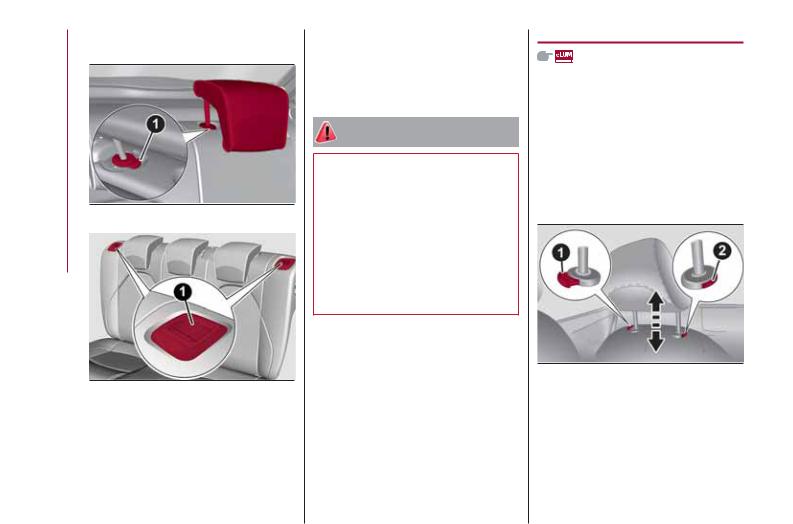
GETTINGTO KNOWYOUR CAR
(the lever 1 raising is highlighted with a “red band”).
12 |
A0J0083C |
|
|
13 |
A0J0082C |
Repositioning the rear seat
Move the seat belts to the side, making sure that they are correctly extended and not twisted.
Raise the previously folded backrest until you hear the click of the locking mechanism, visually checking that the
“red bands” on levers 1 fig. 13 are no longer visible.The “red band” indicates that the backrest is not secured. Finally, reposition the head restraints, inserting them into their housings.
WARNING
6)All adjustments must be made with the car stationary.
7)Once you have released the adjustment lever, always check that the seat is locked on the guides by trying to move it back and forth. If the seat is not locked into place, it may unexpectedly slide and cause the driver to lose control of the car.
8)For maximum safety, keep the backrest upright, lean back into it and make sure the seat belt fits closely across your chest and pelvis.
HEADRESTS
FRONT
These are height-adjustable and lock into the desired position automatically.
To adjust the height, proceed as follows:  upwards adjustment: raise the head restraint until it clicks into place;
upwards adjustment: raise the head restraint until it clicks into place;
 downward adjustment: press button 1 fig. 14 and lower the head restraint.
downward adjustment: press button 1 fig. 14 and lower the head restraint.
 9)
9)
14 |
A0J0130C |
Proceed as follows to remove the head restraints:
 raise the head restraints to their maximum height;
raise the head restraints to their maximum height;
 press buttons 1 and 2, then remove the head restraints by pulling them upwards.
press buttons 1 and 2, then remove the head restraints by pulling them upwards.
16
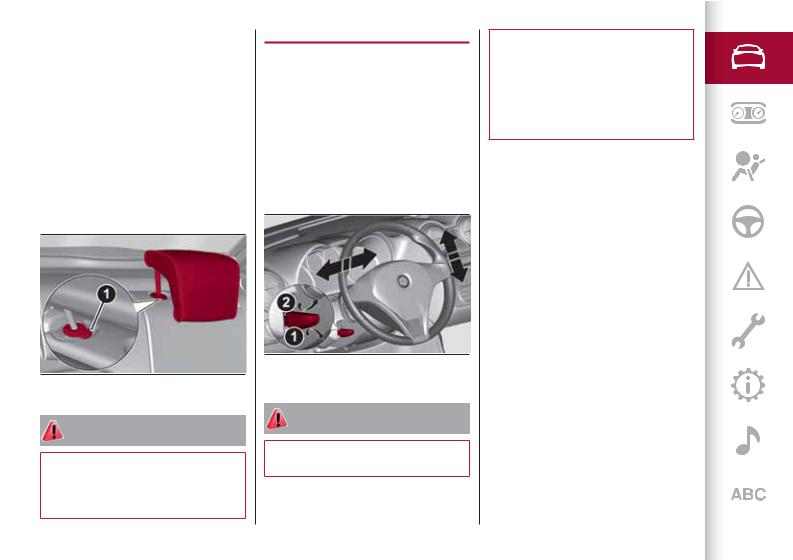
REAR
Two height-adjustable head restraints are provided for the back seats (for the adjustment see the previous paragraph). On some versions a head restraint is also provided for the central seat.
Proceed as follows to remove the head restraints:
 raise the head restraints to their maximum height;
raise the head restraints to their maximum height;
 press buttons 1 fig. 15 then remove the head restraints by pulling them upwards.
press buttons 1 fig. 15 then remove the head restraints by pulling them upwards.
15 |
A0J0083C |
WARNING
9) Head restraints must be adjusted so that the head, rather than the neck, rests on them. Only in this case they can protect your head correctly.
STEERING WHEEL
 10) 11)
10) 11)
It can be adjusted axially and vertically. To adjust, release the lever 1 fig. 16 by pushing it forwards (position A) and adjust the steering wheel. Having made the adjustment, lock lever 1 by pulling it towards the steering wheel (position B). NOTE “Veloce” and “Sport” versions are equipped with sports configuration steering wheel.
16 |
A0J0034C |
WARNING
10) All adjustments must be carried out only with the car stationary and engine off.
11) It is absolutely forbidden to carry out any after-market operation involving steering system or steering column modifications (e.g. installation of anti-theft device) that could adversely affect performance and safety, invalidate the warranty and also result in the car not meeting type-approval requirements.
17
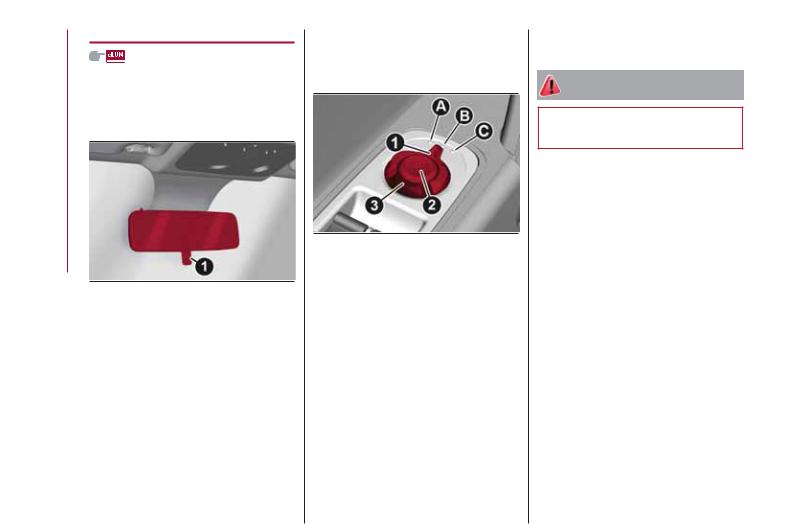
GETTINGTO KNOWYOUR CAR
REAR VIEW MIRRORS
INTERIOR MIRROR
Manual adjustment: operate lever 1 fig. 17 to adjust the mirror between two positions: normal or anti-glare.
17 |
A0J0108C |
Electrochromic mirror
Some versions are equipped with an electro-chrome mirror with an ON/OFF switch to activate/deactivate the electro-chrome function.When reverse gear is engaged, the mirror is automatically set for daytime use.
DOOR MIRRORS
 12)
12)
Electric adjustment
The mirrors can be adjusted/folded away only if the ignition key is in the MAR position.
Select the desired mirror using device 1 fig. 18:
 Position A: left mirror selected;
Position A: left mirror selected;  Position C: right mirror selected.
Position C: right mirror selected.
18 |
A0J0022C |
To adjust the selected mirror, press button 2 in the four directions shown by the arrows.
IMPORTANT Once adjustment is complete, rotate device 1 to position B to prevent accidental movements.
Electrical mirror folding
(where present)
To fold the mirrors, press button 3. Press the button again to restore the mirrors to the driving position.
Manual mirror folding
When required, fold the mirrors in towards the vehicle.
IMPORTANTWhen driving, the mirrors must always be open.
WARNING
12) As the driver's door mirror is curved, it may slightly alter the perception of distance.
18

EXTERNAL LIGHTS
The left stalk fig. 19 operates most of the exterior lights.The external lights can only be switched on when the ignition key is at MAR.
19 |
A0J0063C |
DAYTIME RUNNING LIGHTS (DRL)
"Daytime Running Lights"
With the ignition key at MAR and ring nut 1 turned to position, the daytime running lights switch on.The other lights and interior lighting stay off.
position, the daytime running lights switch on.The other lights and interior lighting stay off.
IMPORTANTThe daytime running lights are an alternative to the dipped headlights for driving during the daytime in countries where it is compulsory to have lights on during the day; where it is not compulsory, the use of daytime running lights is permitted.
IMPORTANT Daytime running lights cannot replace dipped beam headlights when driving at night or through tunnels. The use of daytime running lights is governed by the Highway Code of the country in which you are driving. Comply with legal requirements.
SIDE LIGHTS/DIPPED BEAM HEADLIGHTS
With the ignition key turned to MAR, turn the ring nut 1 to .
.
The daytime running lights are switched off and the side lights and dipped headlights are switched on.The
 warning light switches on in the instrument panel.
warning light switches on in the instrument panel.
PARKING LIGHTS
These lights can only be switched on with ignition key at STOP or removed, by moving ring nut 1 first to position and then to
position and then to position.
position.
With the parking lights, also the plate lights and front and rear direction lights (daytime running lights DRL remain switched off) switch on.
The warning light switches on in the instrument panel.
warning light switches on in the instrument panel.
Operate the direction indicator stalk to select the light side (right or left)
AUTOMATIC LIGHTING CONTROL (AUTOLIGHT) (Dusk sensor)
(where provided)
A sensor, located on the windscreen, detects the variations in outside brightness depending on the light sensitivity set with the Setup Menu: the greater the sensitivity, the less external light is required to activate the exterior lights.
Activation
Turn the ring 1 to the position to activate automatic control of the dipped beam headlights and taillights according to the external light conditions.
position to activate automatic control of the dipped beam headlights and taillights according to the external light conditions.
When the lights are automatically switched off, the front and rear fog lights (if activated) are also switched off.The next time the lights are switched on automatically, the fog lights must be reactivated manually (if required).
The headlights can only be flashed with the sensor on.To activate the dipped beam headlights, turn ring 1 to the position and then switch on the dippd beam headlights.
and then switch on the dippd beam headlights.
MAIN BEAM HEADLIGHTS
To activate the main beam headlights, with ring nut 1 to , pull the stalk towards the steering wheel beyond the end of travel position.The
, pull the stalk towards the steering wheel beyond the end of travel position.The warning light switches on in the instrument panel.
warning light switches on in the instrument panel.
19
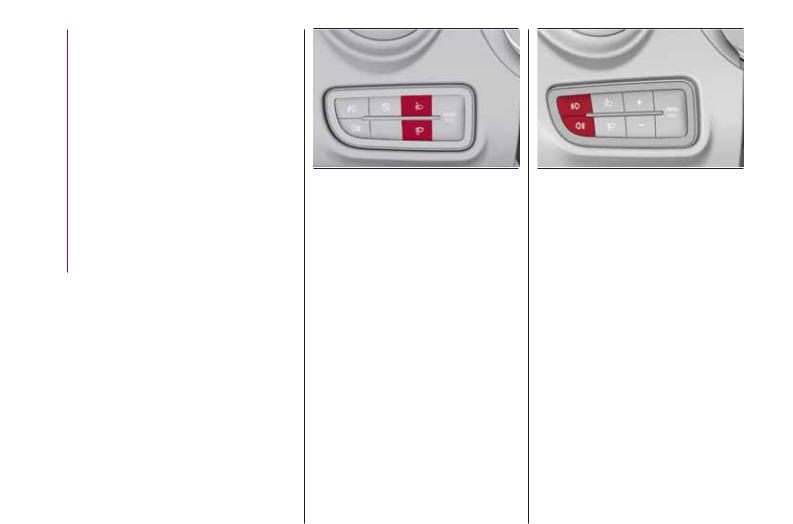
GETTINGTO KNOWYOUR CAR
When the stalk is pulled towards the steering wheel again, beyond the end of travel position, the main beam headlights deactivate, the dipped headlights reactivate and the  warning light switches off.
warning light switches off.
It is not possible to switch on the main beam headlights constantly if automatic light control is active.
FLASHING
To do this, pull the stalk towards the steering wheel (unstable position), regardless of the position of ring nut 1. The  warning light switches on in the instrument panel.
warning light switches on in the instrument panel.
HEADLIGHT ALIGNMENT CORRECTOR
This device works with the ignition key in the MAR position and the dipped headlights on.
Headlight alignment adjustment
Press buttons  and
and  fig. 20. to adjust.The adjustment position is shown on the display.
fig. 20. to adjust.The adjustment position is shown on the display.
 Position 0: one or two people on the front seats.
Position 0: one or two people on the front seats.
 Position 1: 4 people.
Position 1: 4 people.
 Position 2: 4 people + load in luggage compartment.
Position 2: 4 people + load in luggage compartment.
 Position 3: driver + maximum permitted load stowed in the luggage compartment.
Position 3: driver + maximum permitted load stowed in the luggage compartment.
20 |
A0J0306C |
NOTEThe button panel can change according to the versions.
IMPORTANT Check the alignment every time the load carried changes.
FRONT FOG LIGHTS
(where provided)
Operation
Press the button  fig. 21 to switch the lights on/off.With the lights on, the warning light
fig. 21 to switch the lights on/off.With the lights on, the warning light  in the instrument panel switches on.
in the instrument panel switches on.
21 |
A0J0303C |
REAR FOG LIGHT
Operation
Press the button  to switch the lights on/off.
to switch the lights on/off.
The rear fog light switches on only when the dipped headlights are on.
Press the button again to switch the light off.
With the light on, the warning light  in the instrument panel switches on.
in the instrument panel switches on.
DIRECTION INDICATORS
Bring the stalk to the (stable) position:  upwards: activates right direction indicator;
upwards: activates right direction indicator;
 downwards: activates left direction indicator.
downwards: activates left direction indicator.
The  or
or warning light will blink on the instrument panel.
warning light will blink on the instrument panel.
20
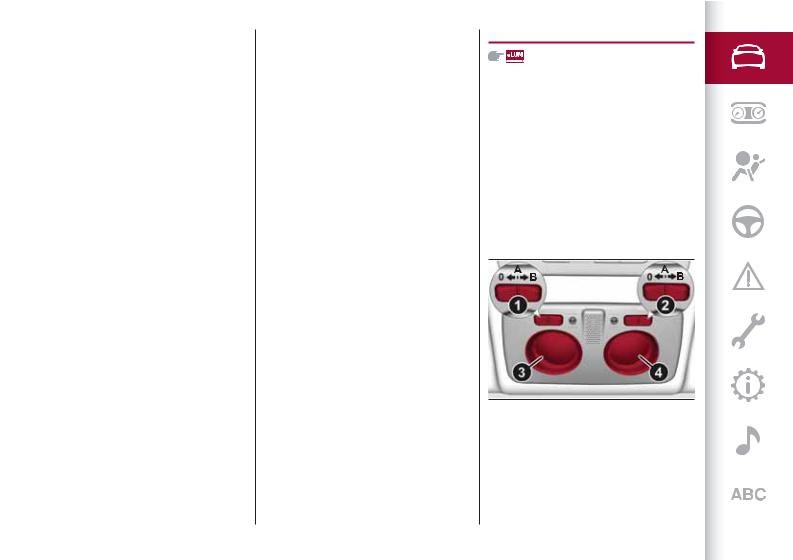
The direction indicators are switched off automatically when the steering wheel is straightened.
"Lane change" function
If you wish to signal a lane change, place the left stalk in the unstable position for less than half a second.The direction indicator on the selected side flashes three times and then switches off automatically.
"FOLLOW ME HOME" DEVICE
This device allows you to illuminate the area in front of the car for a certain amount of time.
Activation
With the key turned to STOP or removed, pull the left-hand stalk 1 towards the steering wheel within 2 minutes from when the engine is turned off.
Each time the stalk is moved, the lights stay on for an extra 30 seconds up to a maximum of 210 seconds; then the lights are switched off automatically.
When the stalk is operated, the warning light on the instrument panel switches on.The display shows a message and the time set for the function.
on the instrument panel switches on.The display shows a message and the time set for the function.
The warning light comes on when the stalk is operated and stays on until the function is automatically deactivated.
Each movement of the stalk only increases the amount of time the lights stay on.
Deactivation
Keep the stalk pulled towards the steering wheel for more than 2 seconds.
EXTERNAL COURTESY LIGHTS
These light up the car and the space in front of it when the doors are unlocked.
Activation
When the car is parked and the doors are unlocked by pressing the button on the remote control (or the luggage compartment is unlocked by pressing
button on the remote control (or the luggage compartment is unlocked by pressing  ), the dipped beam headlights, rear side lights and number plate lights are activated.
), the dipped beam headlights, rear side lights and number plate lights are activated.
The lights stay on for approximately
25 seconds unless the doors and luggage compartment are locked again with the remote control or the doors (or luggage compartment) are opened and reclosed. In these cases they switch off after
5 seconds.
INTERIOR LIGHTS
FRONT CEILING LIGHT
Switch 1 fig. 22 is used to switch on/off roof lights.
Switch 1 positions:
 central position (A position): lights
central position (A position): lights
3 and 4 switch on/off when the doors are opened/closed;
 pressed to the left (0 position): lights 3 and 4 are always switched off;
pressed to the left (0 position): lights 3 and 4 are always switched off;
 pressed to the right (B position): lights 3 and 4 are always switched on.
pressed to the right (B position): lights 3 and 4 are always switched on.
Lights switch on/off progressively.
22 |
A0J0066C |
Switch 2 fig. 22 operates the map reading light.
Switch 2 positions:
 central position (A position): lights 3 and 4 are always switched off;
central position (A position): lights 3 and 4 are always switched off;
21
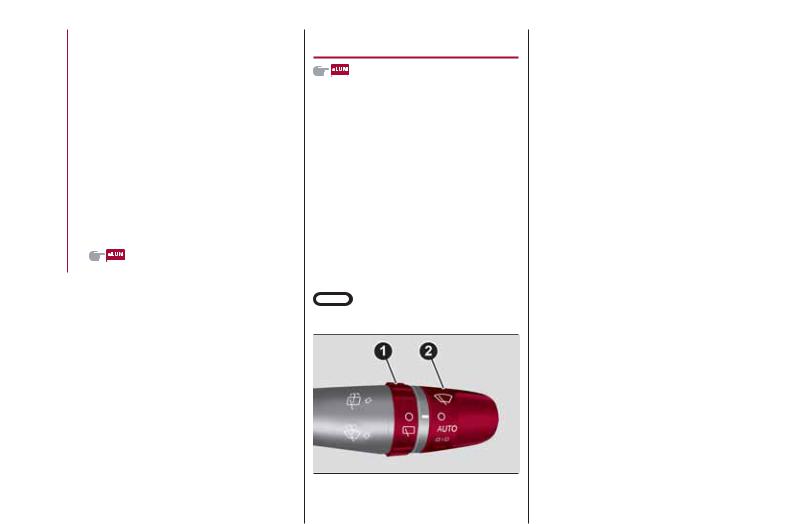
GETTINGTO KNOWYOUR CAR
 pressed to the left (0 position): light 3 switches on;
pressed to the left (0 position): light 3 switches on;
 pressed to the right (B position): light 4 switches on.
pressed to the right (B position): light 4 switches on.
IMPORTANT Before getting out of the car, make sure that both switches are in the central position: when the doors are closed the lights will switch off to avoid draining the battery. In any case, if the switch is left in the on position, the roof light switches off automatically about 15 minutes after the engine has been switched off.
ROOF LIGHTTIMING
Timing while getting into the car
The roof lights come on won unlocking, opening and closing.The timed period is interrupted when the ignition is turned to "MAR-ON".
Timing while getting out of the car
The roof lights come on when the key is removed from the ignition within
2 minutes of switching off the engine, on opening and closing a door with the removed key.The timing stops automatically when the doors are locked.
WINDSCREEN / REAR WINDOW WIPERS
This operates only with the ignition key turned to MAR.
WINDSCREEN WASHER / WIPER
Operation
 13) 14)
13) 14)
Ring 2 fig. 23 can be set to the following positions:
O – windscreen wiper off;
 – intermittent operation (low speed);
– intermittent operation (low speed);
AUTO – rain sensor on (where provided);  – intermittent operation;
– intermittent operation;
– continuous slow operation;
 – continuous fast operation.
– continuous fast operation.
23 |
A0J0064C |
Move the stalk upwards (unstable
position) to limit operation to the time for which the stalk is held in this position. When released, the stalk will return to its default position and the windscreen wiper will be automatically stopped.
“Smart washing” function
Pull the stalk towards the steering wheel (unstable position) to operate the windscreen washer. Keep the stalk pulled for more than half a second to operate the windscreen washer jet and wiper automatically with a single movement. The windscreen wiper stops working three strokes after the stalk is released. A further stroke after approx. 6 seconds completes the wiping cycle.
RAIN SENSOR
(where provided)
It can detect the presence of rain and consequently manage windscreen wiping in accordance with the amount of water on the windscreen.
The sensor is activated when the ring 2 is turned to “automatic” position (“AUTO” control): the windscreen wiper stroke frequency is thus adjusted in accordance with the amount of water on the windscreen.
If no rain is detected, the wiper will not carry out any strokes.
22

REAR WINDOWWIPER / WASHER
(where provided)
This operates only with the ignition key turned to MAR.
Turn ring 1 from O position to
 position to operate the rear window wiper as follows:
position to operate the rear window wiper as follows:
 in intermittent mode when the windscreen wiper is not operating;
in intermittent mode when the windscreen wiper is not operating;  in synchronous mode (at half the
in synchronous mode (at half the
speed of the windscreen wiper) when the windscreen wiper is operating;
 in continuous mode with reverse gear engaged and the control active. Pushing the stalk towards the dashboard (rocking position) will activate the rear
in continuous mode with reverse gear engaged and the control active. Pushing the stalk towards the dashboard (rocking position) will activate the rear
window washer jet. Keep the stalk pushed for more than half a second to activate the rear window wiper as well. Releasing the stalk will activate the smart washing function, as described for the windscreen wiper.
WARNING
13) Never use the windscreen wipers to remove layers of snow or ice from the windscreen. In such conditions, the windscreen wiper may be subjected to excessive stress and the motor cut-out switch, which prevents operation for a few seconds, may intervene. If operation is not restored (even after restarting that car with the key), contact an Alfa Romeo Dealership.
14) Do not operate the windscreen wiper with the blades lifted from the windscreen.
23
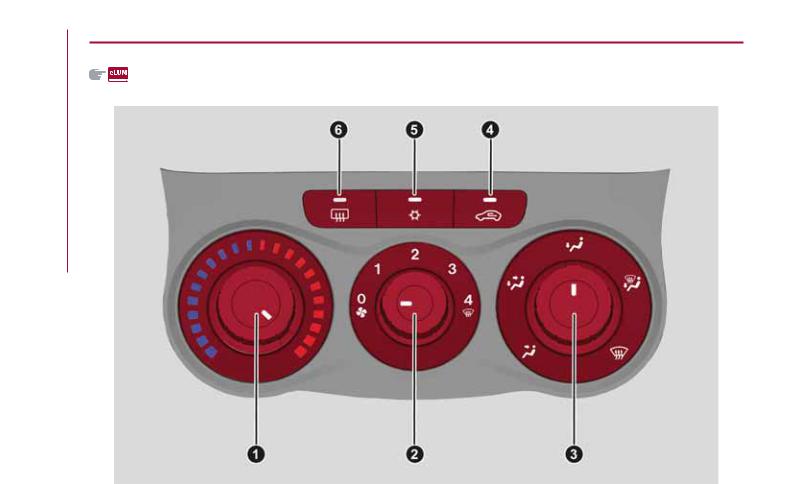
GETTINGTO KNOWYOUR CAR
CLIMATE CONTROL
CLIMATE CONTROL / HEATING SYSTEM
24 |
A0J0074C |
24

1 - air temperature adjustment knob: blue section = cold air / red section = hot air
2 - fan activation/adjustment knob: 0  = fan switched off / 1-2-3= fan speed / 4
= fan switched off / 1-2-3= fan speed / 4  = maximum fan speed 3 - air distribution knob
= maximum fan speed 3 - air distribution knob
air flow towards driver/passenger body
air flow towards driver/passenger and feet area;
air flow towards front and rear footwell;
air flow towards feet area and windscreen;
air flow towards windscreen
4 - air recirculation on/off button (It is advisable not to use the air recirculation function when the outside temperature is low to prevent the windows from rapidly misting up);
5 - climate control compressor on/off button;
6 - heated rear window on/off button.
25
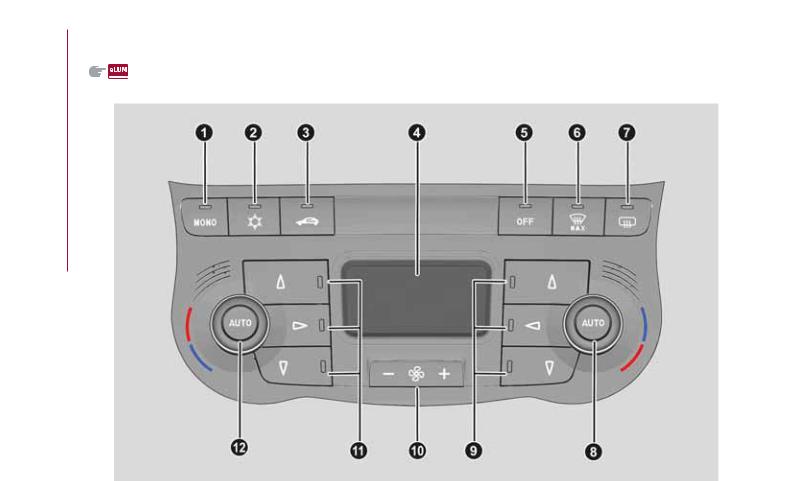
GETTINGTO KNOWYOUR CAR
AUTOMATIC DUAL-ZONE CLIMATE CONTROL SYSTEM
(where provided)
25 |
A0J0037C |
26

1 - MONO function button (set temperature alignment) driver/passenger side; 2 - climate control compressor on/off button;
3 - air recirculation on/off button (It is advisable not to use the air recirculation function when the outside temperature is low to prevent the windows from rapidly misting up);
4 - display;
5 - climate control system off button;
6 - button for activating the MAX-DEF function (fast front window defrosting/demisting); 7 - heated rear window on/off button;
8 - AUTO function activation button (automatic operation) and passenger side temperature adjustment knob; 9 - passenger side air distribution selection button;
10 - fan speed increase/decrease;
11 - driver's side air distribution selection button;
12 - AUTO function activation button (automatic operation) and driver side temperature adjustment knob;
Air distribution selection
 Air flow to the windscreen and front side window vents to demist/defrost them.
Air flow to the windscreen and front side window vents to demist/defrost them.
 Air flow at central and side dashboard vents to ventilate the chest and the face during the hot season.
Air flow at central and side dashboard vents to ventilate the chest and the face during the hot season.
 Air flow to the front and rear footwell vents.This air distribution setting heats the passenger compartment most quickly, giving a prompt sensation of warmth.
Air flow to the front and rear footwell vents.This air distribution setting heats the passenger compartment most quickly, giving a prompt sensation of warmth.
In FULL AUTO mode, the climate control system automatically manages air distribution (the LEDs on buttons 9 and 11 are off).When set manually, the air distribution is indicated by the LEDs on the selected buttons switching on
You can also set a combination of the air distribution settings described above. In combined function mode the relevant function is enabled simultaneously with those already set by pressing the corresponding button. If a button whose function is already active is pressed, the operation is cancelled and the corresponding LED switches off.To restore automatic control of the air distribution after a manual selection, press the AUTO button.
27

GETTINGTO KNOWYOUR CAR
CLIMATE CONTROL SYSTEM
Climate control system adopts R-1234yf cooling gas with low environmental footprint (GWP < 150) according to “MAC Directive”.
Any refuelling must be done with specific oil, as indicated on the plate (in engine compartment) shown in fig. 26. For this operation, contact an Alfa Romeo Dealership.
26 |
A0J0999C |
28
